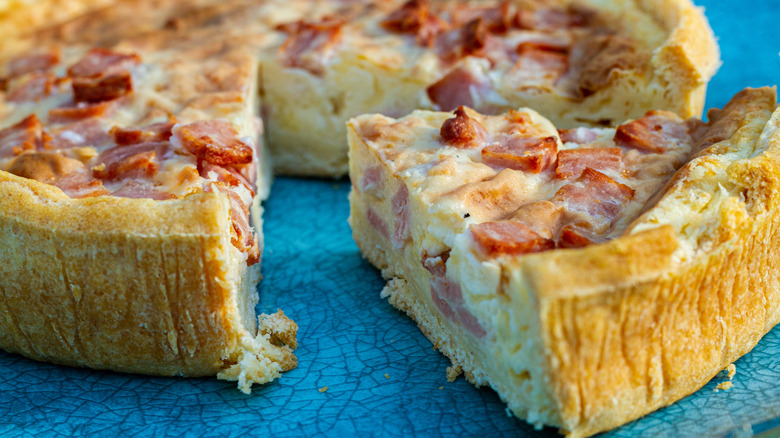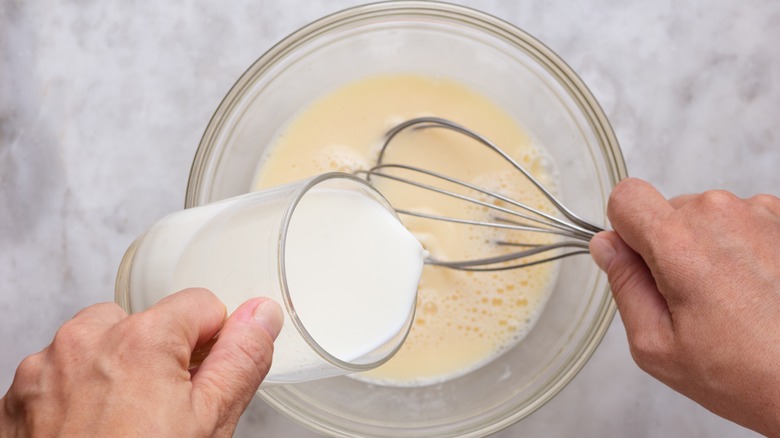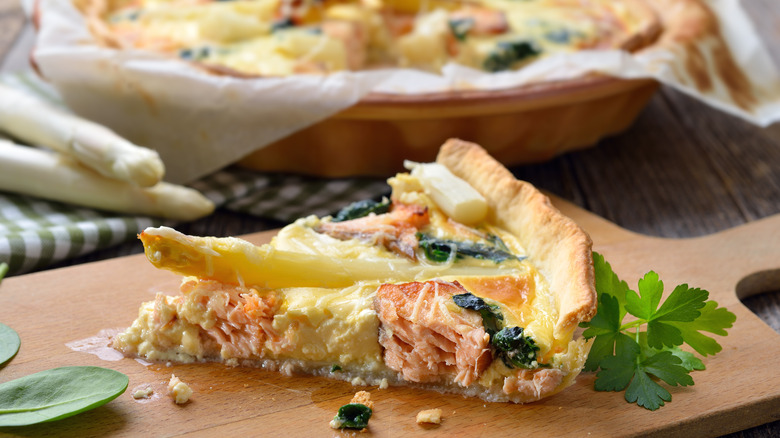The Egg-To-Dairy Ratio You Should Know For Silkier Quiches
A quiche is a great example of a dish that's both simple and sophisticated. Simple in that it consists of basic ingredients that are combined and baked into a crust, and sophisticated when you consider that the texture can be both creamy and silky, which takes a precise combination of ingredients.
A perfect quiche does not resemble the scrambled egg consistency of a frittata, as similar as they may seem, so the same ratio of ingredients would not apply. For a quiche's lovely custard-like finish, you should use a half-cup of milk for every large egg that you're using in the recipe. So, if you're cracking three eggs for your quiche, you'd want to use 1.5 cups of milk.
A quiche's texture is created when the fat from the milk combines with the protein of the eggs, making something that resembles gel, but when it bakes, it becomes creamy and rich. The finished product should be a tad wobbly when it comes out of the oven but it shouldn't be rubbery. A well-made quiche is really like no other egg dish: the flavors, method, and ingredients are simple but getting the consistency right makes the dish seem ethereal.
The silkiest quiches come from the dairy fat
A quiche is basically a kind of savory custard pie, and it should feel like one. For the silkiest, creamiest texture, you need a good amount of fat, so using whole milk, half-and-half, or even heavy cream will give you the best results. Low- or non-fat milk will certainly create a tasty quiche, too, but it won't have the same velvety consistency.
With all the liquid involved in making a creamy quiche, determining when it's fully baked might be tricky for some. Relying on cues will help, in particular ones that tell you the quiche is not liquid but is a bit wobbly; and, when sticking a toothpick inside, it should come out damp but not wet. Of course, this can all leave even experienced cooks scratching their heads.
For a no-fail answer, use an instant read thermometer, and place it right in the center of the baked quiche, or where the filling is thickest. Egg dishes like quiches are considered fully cooked when they reach 160 degrees Fahrenheit. Once it's cooked and you take it out of the oven, you should let it rest for quite a while, ideally to room temperature. You can even make it a day ahead of time and place it in the fridge once it's cooled.
More tips for better quiches
Once you've mastered the right egg-to-dairy ratio of your homemade quiches, you've tackled the trickiest part of the process, but even though you've achieved the perfect custard texture doesn't mean you can't pay attention to some other details. For starters, blind baking your crust is essential, like you would do for pies or tarts. Don't worry, it's not as scary as it sounds; blind baking is simply pre-baking your crust first before you pour your egg mixture in. If you don't, you're destined to have a dreaded soggy bottom on your quiche even if your custard filling is flawless.
In addition, be mindful of your quiche fillings and flavorings and avoid using anything that will add too much liquid to the mix, which could affect the custard consistency. Vegetables like zucchini, mushrooms, spinach, and tomatoes are wonderful in quiches, but will also seep a ton of liquid. Also, cook your vegetables first so that the liquid in them evaporates. When it comes to spinach, squeeze the excess liquid out of it even after it's cooked.
Finally, don't be afraid to be bold with your fillings. Classic quiche flavors like Lorraine and Florentine are scrumptious, but try thinking outside of the box, too. For example, use leftover salmon, broccolini, and goat cheese; try a chile relleno-inspired version with melty jack and cheddar cheeses and green chiles; or consider cooked slices of potato, leeks, and nutty gruyere cheese.



